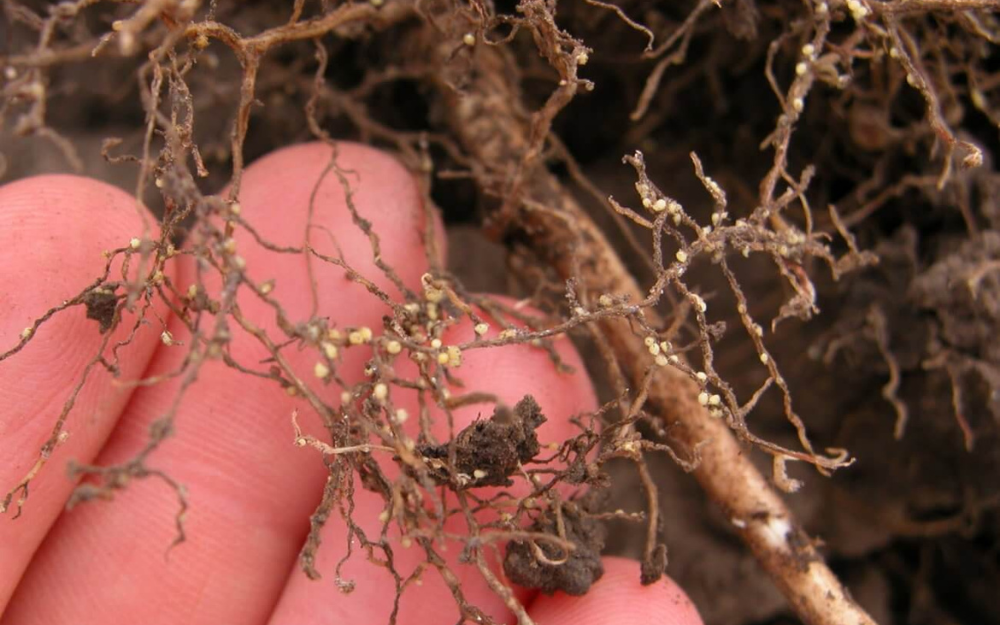Soybean Cyst Nematode (SCN) may be elusive to the naked eye, but its impact on soybean crops is undeniable. Let’s dive into the symptomology, pathogen characteristics, and practical strategies for managing this silent threat to soybean production.
Understanding Soybean Cyst Nematode
Diagnosing SCN involves a meticulous examination of roots, where visible females and cysts (white to yellow lemon-shaped) become apparent from July through the end of the season. Even at low levels, above-ground symptoms can be elusive, causing yield losses ranging from 15-30%. Severe damage may manifest in oval to elliptical outlines in plant stress areas. High Ph soils can favor SCN. Infections of SCN can also potentially increase other soil-borne soybean diseases such as brown stem rot, sudden death syndrome, and fusarium root rot. Soil samples should be taken and sent to a diagnostic laboratory to determine the population.
Effective Sampling Techniques for Soybean Cyst Nematode
Sampling should be done close to harvest time (September/October), aiming for the roots. Using a soil probe at a depth of 6-8 inches, take 10-20 small samples, mix them up, and create a composite sample. When sampling we are measuring the number of eggs in the soil, which are measured in 100CC of soil (which is approximately 3.4 ounces).
Areas to sample:
- Field entrances (SCN being moved on equipment)
- Low spots where water pools (SCN moving in water)
- Along shelter belts or fence lines (SCN moving with wind-dispersed soil)
- Areas of unexplained low yields
- Areas that turn yellow in August (heavy SCN damage may show up as stunted or yellow beans when it is hot and dry late in the season)
Where to Send Samples for Testing
- North Dakota Soybean Council – free up to 2000 samples per year
- Sam Markell at NDSU: Samuel.markell@dnsu.edu 701-231-8362
- Minnesota Soybean Research & Promotion Council – 1,750 free per year
- Angie Peltier At U of M: apeltier@umn.edu 218-281-8692
- AGVISE: 902 13th St N, Benson, MN 56215 320-843-4109
Understanding the Numbers:
Interpreting the number of eggs per 100 cc of soil is crucial in determining the risk and appropriate actions:
- <200 eggs/100 cc soil: Low risk; SCN susceptible variety can be grown.
- 201-2000 eggs/100 cc soil: Yield loss would be expected when growing a SCN susceptible and a resistant variety is recommended.
- 2001-10,000 eggs/100 cc soil: Expects some yield loss even when growing a SCN resistant variety
- 10,000 eggs/100 cc soil: Soybean production is not recommended. Growers should consider poor or non-host crops other than soybeans until egg counts decrease in the following years.
Poor or Non-Host Crops
Alfalfa, Barley, Buckwheat, Canola, Corn, Flax, Oat, Pea, Potato, Red Clover, Sorghum, Sugar beet, Sunflower, Wheat, and White Clover.
Soybean Cyst Nematode Resistant Varieties:
Not all resistant varieties are the same. 90% of the varieties available today have the PI88788-resistant gene. After 20 years of use, PI 88788 is not a viable source of resistance due to SCN populations now able to overcome PI 88788 and reproduce eggs.
Varieties, however limited, containing the PEKING source of resistance are recommended as a more effective source to limit nematode reproduction and the buildup of SCN in the soil.
Seed Treatments
Seed treatments provide additional protection and can increase yields 1-5 bushels per acre but are not a substitute for the use of effective SCN varieties and or Non-Host Crop.
We recommend Salto Nematicide (1.52 floz/cwt) along with a Peking traited soybean for those counts between 2001-10,000 eggs/100 cc Soil, to reduce the buildup of SCN numbers.
Strengthen Your Soybean Defense Today!
Managing Soybean Cyst Nematode requires a comprehensive approach, from effective sampling and understanding population numbers to choosing resistant varieties and implementing seed treatments. By staying vigilant and adopting appropriate strategies, growers can minimize the impact of SCN on soybean production. If you are looking for assistance or have questions, please reach out to us!

